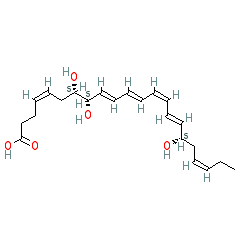GtoPdb is requesting financial support from commercial users. Please see our sustainability page for more information.
|
Abbreviated name: RvD1
Synonyms: 7S,8R,17S‐trihydroxy‐4Z,9E,11E,13Z,15E,19Z‐docosahexaenoic acid
Compound class:
Metabolite
Comment: This is a D (docosahexaenoic acid) series resolvin. There is some ambiguity in the literature and on online resources as to the exact stereochemistry of resolvin D1. The structure shown here is the same as that shown in the PubChem entry linked to above, while other common representations include CID 44251266 and CID 16061135.
Ligand Activity Visualisation ChartsThese are box plot that provide a unique visualisation, summarising all the activity data for a ligand taken from ChEMBL and GtoPdb across multiple targets and species. Click on a plot to see the median, interquartile range, low and high data points. A value of zero indicates that no data are available. A separate chart is created for each target, and where possible the algorithm tries to merge ChEMBL and GtoPdb targets by matching them on name and UniProt accession, for each available species. However, please note that inconsistency in naming of targets may lead to data for the same target being reported across multiple charts. ✖ |
|
|||||||||||||||||||||||||||||||||||
| Natural/Endogenous Targets | |||
|
|||
| Selectivity at GPCRs | |||||||||||||||||||||||||||||||||||||||||||||||||||||||
| Key to terms and symbols | Click column headers to sort | ||||||||||||||||||||||||||||||||||||||||||||||||||||||
|
|||||||||||||||||||||||||||||||||||||||||||||||||||||||
| Selectivity at ion channels | ||||||||||||||||||||||||||||||||||
| Key to terms and symbols | Click column headers to sort | |||||||||||||||||||||||||||||||||
|
||||||||||||||||||||||||||||||||||
| Additional information and targets (data relate to human unless otherwise stated) | ||
| Description | Data | Reference |
| Potency order of endogenous ligands at GPR32 | resolvin D1 > LXA4 | |
| Potency order of endogenous and other ligands at FPR2 |
For lipid mediators (resolving) LXA4 = aspirin triggered lipoxin A4 = ATLa2 = resolvin D1 >> 15-deoxy-LXA4 > C16:0 ceramide For other ligands: WKYMVm > BMS-986235 > ACT-389949 > mitochondrial formyl peptides |
4,9-13,15-16,18-21,24 |
| Potency order of endogenous agonists at FPR2 |
Lipid mediators for resolution of inflammation: LXA4 = aspirin triggered lipoxin A4 = ATLa2 = resolvin D1 > LTC4 = LTD4 >> 15-deoxy-LXA4 >> C16:0 ceramide Proteins and peptides for balanced activation: fMLKLIV = fMTPMRKINPLMKLIN > serum amyloid A (SAA1, P0DJI8) > LL-37 (CAMP, P49913) |
4,8-11,13,16,23-24 |
| Targets where the ligand is described in the comment field | |
| Target | Comment |
| GPR32 | Resolvin D1 has been demonstrated to activate GPR32 in two publications [3,14]. The pairing was not replicated in a recent study based on arrestin recruitment [22]. GPR32 is a pseudogene in mice and rats. See reviews [2] and [7]. |
| Ligand mentioned in the following text fields |
| Chemerin receptors overview |
| Leukotriene receptors comments |









